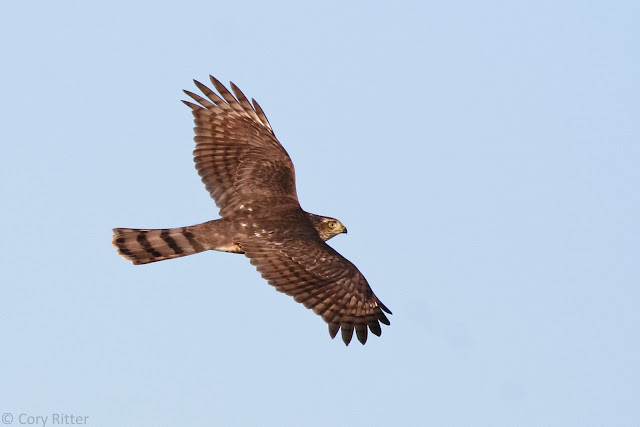The date was September 26, 2013. It was a windy day. Bad weather had pretty much dominated the forecast for several days. I was outside when I heard Jim's thunderous voice come through the radio, "Sandhill Crane, there's a Sandhill Crane over East Landing." I ran out the door and there was a crane flying in closer and closer. This was the second record of Sandhill Crane so everyone was ecstatic.
Eventually the bird landed, and we crept up to get some photos. Little did we know, this bird would stay with us for a while.
 |
| Craney Crane |
We all felt sorry for this poor juvenile crane who must have gotten separated from her flock, and blown off course to end up on this place – surely a wasteland for any crane. But on the first day, Don Mastwell took a dead mouse from the mouse trap, chirped a sweet trill the bird's direction, and dangled the tiny rodent by its tail out for the bird to see. The crane, soon to be named Craney Crane, followed by Crane Crane, approached skeptically and plucked the mouse from Donald's hand. It was love at first sight. Crane Crane loved Dan, and Dan loved Crane Crane.
Before long all of us were feeding this lucky bird straight from our hands. But we knew that wasn't right. This was a wild animal after all and it had to learn how to forage by herself. I began giving her foraging lessons. I would sit down and start digging under rocks, turning up beetles and brown funnel-web spiders plump and ripe to a Crane's tastes. But still, she was getting too close. She took too much of a liking too us.
 |
| Dan and his bag of crane food and water |
One day we had a huge wave of migrants and all of us were up on the hill looking through flocks of sparrows and Hermit Thrush (and one Williamson's Sapsucker) only to look out at Crane Crane circling up higher and higher then circling around us. She tried to land at the lighthouse a few times, chirping at us all along. She was jealous of the other birds.
We all decided that the crane, Crane Crane, had overstayed her welcome. We stopped feeding her and foraging with her hoping that she would begin fending for herself. We loved the Crane, sure, and that's why we needed her to forage alone. She needed to build up enough energy to get away, but not have a reason to stay.

We saw her foraging often, then, even catching her own mice and her own spiders. We chased her away from our nets so that she wouldn't try to eat our captured birds, and she grew afraid of us. She started paying close attention to the Brown Pelicans as they flew over, often tilting her head up towards them and calling to them. Eventually she began flying out over the ocean with them. Each time she got further and further away before heading back. She was ready to go. One day Don woke up and looked outside at Crane Crane foraging as usual. Later that morning she was nowhere to be found. Two days later a juvenile Sandhill Crane was seen in Napa. I like to think that that was our Crane Crane.



























